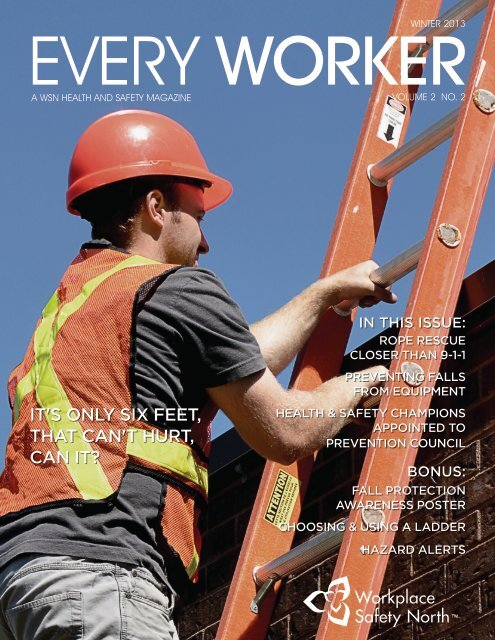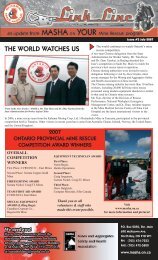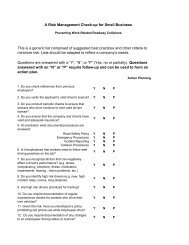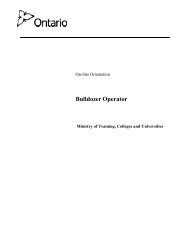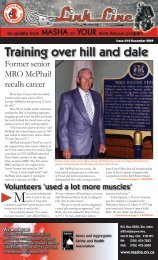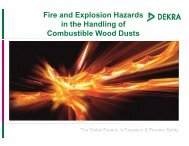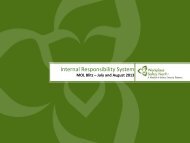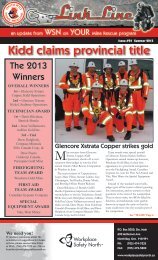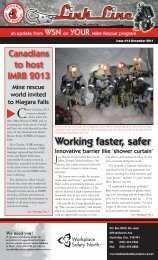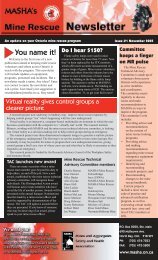EVERY WORKER
Download Every Worker/Winter 2013 - Workplace Safety North
Download Every Worker/Winter 2013 - Workplace Safety North
- No tags were found...
Create successful ePaper yourself
Turn your PDF publications into a flip-book with our unique Google optimized e-Paper software.
WINTER 2013<br />
<strong>EVERY</strong> <strong>WORKER</strong><br />
A WSN HEALTH AND SAFETY MAGAZINE VOLUME 2 NO. 2<br />
IT'S ONLY SIX FEET,<br />
THAT CAN'T HURT,<br />
CAN IT?<br />
IN THIS ISSUE:<br />
ROPE RESCUE<br />
CLOSER THAN 9-1-1<br />
PREVENTING FALLS<br />
FROM EQUIPMENT<br />
HEALTH & SAFETY CHAMPIONS<br />
APPOINTED TO<br />
PREVENTION COUNCIL<br />
BONUS:<br />
FALL PROTECTION<br />
AWARENESS POSTER<br />
CHOOSING & USING A LADDER<br />
HAZARD ALERTS
<strong>EVERY</strong> <strong>WORKER</strong> MAGAZINE Winter 2013 VOLUME 2 NO. 2<br />
CONTENTS<br />
FEATURES<br />
4 It's Only Six Feet<br />
That Can't Hurt, Can It?<br />
6 Rope Rescue<br />
Closer Than 9-1-1<br />
10 Preventing Falls From Equipment<br />
4<br />
12 Choosing and Using a Ladder<br />
50% Knowledge and 50% Taking Time To Work Safely<br />
14 Health and Safety Champions<br />
Appointed to Prevention Council<br />
PLUS... A FALL PROTECTION POSTER... AND...<br />
6<br />
8 How WSN Can Help<br />
9 Paper, Printing and Converting Sector Hazard Alert<br />
Hidden Hazards Can Trip Workers<br />
11 Mining Sector Hazard Alert<br />
Worker Tumbles from Top of LHD<br />
10<br />
13 Forestry Sector Hazard Alert<br />
Routine Maintenance Ends in Fall from Crane<br />
15 WSN Health and Safety Notes<br />
12<br />
For information and resources on "same level falls", see the Fall 2011 issue of<br />
Every Worker, available at WorkplaceSafetyNorth.ca.<br />
2 WorkplaceSafetyNorth.ca
<strong>EVERY</strong> <strong>WORKER</strong><br />
A WSN HEALTH AND SAFETY MAGAZINE<br />
President’s message<br />
A fall can change everything<br />
Joel Swartz, the director of Metron Construction<br />
Corporation, a Toronto constructor, was fined<br />
$90,000 after pleading guilty to violations of<br />
the Occupational Health and Safety Act (OHSA)<br />
after four workers were killed and another<br />
worker was seriously injured.<br />
On December 24, 2009, six workers were on<br />
a suspended work platform, also known as a<br />
swing stage, at a construction project on Kipling<br />
Avenue in Toronto. The swing stage collapsed<br />
and fell 13 floors, killing four of the workers and<br />
seriously injuring another worker. The only worker properly attached<br />
to fall protection was held by the lifeline and pulled to safety.<br />
A Ministry of Labour investigation found that the deceased workers<br />
had not been properly tied off to a lifeline, and had not been properly<br />
trained in the use of fall protection. The swing stage had been<br />
overloaded and it was later determined to be defective and hazardous.<br />
Swartz pleaded guilty under the Act to failing, as a director, to take all<br />
reasonable care to ensure that:<br />
• workers did not use a defective or hazardous swing stage;<br />
• the swing stage was not loaded in excess of the weight it was<br />
meant to bear;<br />
• workers were adequately trained in the use of fall protection by a<br />
competent person.<br />
Metron Construction Corporation was convicted of criminal negligence<br />
causing death and was fined $200,000 in relation to the same incident.<br />
In honour of the men who died and the one who was injured, please<br />
read the life-saving information on safely working at heights in this<br />
issue of Every Worker. On Page 4 Mike Mitchell shares the devastating<br />
consequences (28-inch incision, 97 staples, 9 six-inch screws) of<br />
falling only six feet off a ladder. On Page 10 we look at how not to fall<br />
off mobile equipment. And on Page 6 we look at what’s critical when<br />
prevention fails – a rescue plan. Do you have one?<br />
We hope you discover some new solutions to old problems in this issue<br />
of Every Worker, and we welcome your feedback. Drop me a line and<br />
let me know what you think.<br />
WORKPLACE SAFETY NORTH<br />
690 McKeown Avenue<br />
P.O. Box 2050, Stn. Main<br />
North Bay, ON P1B 9P1<br />
Toll free: 1-888-730-7821 (Ontario only)<br />
Fax: 705-472-5800<br />
WorkplaceSafetyNorth.ca<br />
The information in this publication is<br />
accurate to the best of our knowledge.<br />
WSN assumes no responsibility or<br />
liability for the accuracy or sufficiency<br />
of this information, nor does it endorse<br />
any product mentioned herein with the<br />
exception of those produced by WSN.<br />
If you would like to receive this<br />
magazine electronically email:<br />
First2Know@workplacesafetynorth.ca<br />
For another copy of Every Worker or for<br />
the French version, call us:<br />
Toll free: 1-888-730-7821 (Ontario)<br />
customercare@workplacesafetynorth.ca<br />
For media inquiries, contact:<br />
media@workplacesafetynorth.ca<br />
To arrange for training or if you have any<br />
questions, please direct your inquiry to<br />
our customer care:<br />
Toll free: 1-888-730-7821 (Ontario)<br />
customercare@workplacesafetynorth.ca<br />
Would you like to be notified of new<br />
WSN products, services and events as<br />
they become available?<br />
Join our mailing list by contacting:<br />
First2Know@workplacesafetynorth.ca<br />
Scan this QR code to<br />
visit our Twitter feed.<br />
Candys Ballanger-Michaud<br />
President & CEO<br />
candysballangermichaud@workplacesafetynorth.ca<br />
<strong>EVERY</strong> <strong>WORKER</strong><br />
3
4 WorkplaceSafetyNorth.ca<br />
BY MIKE MITCHELL
"Six hours, 25 minutes on the operating<br />
table, an incision over 28 inches long, nine<br />
six-inch screws, 97 staples, and generous<br />
amounts of pain later"<br />
It would seem only right to first<br />
apologize for not practising<br />
what I preach, I made the<br />
poorest of poor decisions. At<br />
the same time, let me explain<br />
how easy it was to “talk myself”<br />
into getting where I am now.<br />
The job was to develop a lockout for piping changes<br />
during a mill shutdown. About a dozen valves, some<br />
would be used every five years or so but a couple probably<br />
had never been used since they were installed. In order to<br />
help the lockout go smoothly, I decided to lubricate these<br />
valves before the shutdown.<br />
I chose the easiest one to start with, on a pipe about<br />
eight feet off the ground. Ladders were being furiously<br />
collected at this time for the shutdown and I was left with<br />
the bottom half of a 16-foot extension, a little beat up but<br />
still functional with decent feet.<br />
Because of cable trays and other piping, I could not get<br />
the ladder as vertical as needed – little better than 45<br />
degrees. It looked ugly and I knew it. Worse, there was<br />
no place to tie off the bottom. I examined the options,<br />
walking away, finding a better ladder, waiting for help or<br />
taking a chance.<br />
Being the patient type I am, I looked again at the height<br />
and chose the last one. I figured at best I’d be six feet off<br />
the ground and I could jump if anything happened. How<br />
could I get hurt?<br />
From here my day went downhill.<br />
I bounced on the third rung a couple of times. It did not<br />
move so I decided it was good to go. I’d just got eye level<br />
with the cable tray and was transferring tools when I<br />
heard/felt the ladder start to slip. Instinctively I grabbed<br />
the ladder tighter (fat lot of use that was!), next I was on<br />
the ground.<br />
That fast.<br />
The plan to jump, you ask?<br />
Not a hope. Not even time to think about it.<br />
So, to return to the question six feet can’t hurt, can it?<br />
Six hours, 25 minutes on the operating table, an incision<br />
over 28-inches long, nine six-inch screws, 97 staples, and<br />
generous amounts of pain later, I can assure you it can!<br />
The picture says a thousand words.<br />
Bottom line, I’m sworn off ladders for life and my thought<br />
process has changed dramatically. (Closing the door on an<br />
empty stable?)<br />
Faced with countless similar choices workers meet<br />
regularly, I hope you would contemplate what happened<br />
to me when making your decisions. This is one example<br />
you don’t want to follow.<br />
Oh, by the way, that valve I was so “gung-ho” to grease? I<br />
later heard it closed like a “piece of cake” without it.<br />
Go figure.<br />
Mike Mitchell, of Sault Ste. Marie, “(eventually) walked<br />
away with no ill effects” and is now retired.<br />
<strong>EVERY</strong> <strong>WORKER</strong><br />
5
Rope Rescue<br />
Closer than 9-1-1<br />
A rescue procedure should<br />
be the final part of any fall<br />
protection plan for working at<br />
heights, and that procedure<br />
should be more than calling 9-1-1<br />
when, in a worst-case scenario,<br />
a worker is suspended at height<br />
and possibly injured.<br />
Shawn Kirwan, an Emergency Services Specialist with<br />
Ontario Mine Rescue, a part of Workplace Safety North,<br />
helps companies prepare for when they need to take<br />
action. Kirwan teaches a variety of emergency response<br />
courses, including a high-angle rope rescue course for<br />
companies that have workers at risk of falling from heights.<br />
6 WorkplaceSafetyNorth.ca
Many of the companies that participate in the course are<br />
mining companies that have operations in locations distant<br />
or remote from emergency services. But not even all modern<br />
urban emergency services have the equipment or the<br />
expertise to do high-angle rope rescue, Kirwan says, and for<br />
those that do, they may not be at the nearest station.<br />
So calling 9-1-1 may not necessarily prompt a rescue,<br />
never mind a timely rescue. Trained volunteer workplace<br />
responders, however, can provide a timely response.<br />
A swift rescue is important because the suspended worker’s<br />
life may be hanging in the balance. The worker may have<br />
fallen because he or she was injured, or may have been injured<br />
in the fall, and in either case requires medical attention.<br />
Delayed response could contribute to the worker panicking.<br />
As well, while suspended, a worker is at risk of suffering<br />
suspension trauma or orthostatic shock, which occurs when<br />
the leg straps of a harness restrict blood circulation, causing<br />
blood to pool in the legs. Suspension trauma can occur<br />
in as little as five minutes, resulting in the worker losing<br />
consciousness and even dying.<br />
Kirwan’s classroom presentation and course materials cover<br />
the basics of rope rescue equipment and techniques, including<br />
rigging configurations, rescue knots and anchorages. But his<br />
two-day course places an emphasis on hands-on activities.<br />
Extensive practical exercises at elevation include the raising<br />
and lowering of personnel, the slinging of stretchers, and the<br />
pick-off maneuver for the rescue of a suspended casualty.<br />
Though Ontario Mine Rescue has access to the Alertec<br />
firefighting training facility in Azilda, near Sudbury to<br />
present the course, Kirwan prefers to offer the course<br />
to companies on-site. That way, he says, the volunteer<br />
responders are not only training in the environment and<br />
the work areas in which they might have to respond, but<br />
the practical exercises can be tailored to the emergency<br />
situations they may encounter.<br />
As well, site-specific issues, such as anchorage locations, can<br />
be examined and addressed in training. Familiarity with their<br />
own facility gives industrial responders an advantage over<br />
equipped and trained municipal services.<br />
The course is developed for use with the GripTech SP2 Rope<br />
Rescue System, a versatile mechanical advantage system<br />
specifically designed for fire departments and industrial<br />
rescue teams, in broad use across Ontario.<br />
The GripTech system allows rescuers to be vertically raised<br />
or lowered from one level to another or for raising victims<br />
to a surface area. It can easily be switched from controlled<br />
lowering to raising, and can be used for any angle – horizontal<br />
to vertical – rescue.<br />
Another attraction of the GripTech is that it and the<br />
half-inch safety rope it uses, is designed to a maximum<br />
two-person load of 600 lbs., Kirwan says, that permits<br />
a rescuer to be raised or lowered with a casualty,<br />
simplifying rescue operations.<br />
However, the emergency services specialist will tailor the<br />
training and practical exercises to whatever rescue rigging<br />
or other emergency equipment that a company uses. The<br />
intent of the course is to help companies be prepared to act,<br />
and provide the final part of their fall protection plan.<br />
<strong>EVERY</strong> <strong>WORKER</strong><br />
7
How WSN can help:<br />
Workplace Safety North offers a range of<br />
products to help workplaces improve their fall<br />
prevention training programs including:<br />
TRAINING<br />
Focus on Falls<br />
People are falling — statistics are not. In Ontario, approximately 80 people<br />
fall at work every day. This half-day course provides participants with<br />
information and guidance and controlling slip, trip and fall hazards in the<br />
workplace. Participants also learn how to develop and implement a fall<br />
prevention program.<br />
Fall Protection Awareness Online<br />
This Internet-based training program provides a valuable one-hour overview of<br />
why fall protection systems are important, what the law requires regarding fall<br />
protection, and how fall hazards in the workplace can be eliminated or prevented.<br />
High Angle/Confined Space Rescue Training<br />
This course, which may be presented on-site if suitable facilities are available,<br />
offers a combination of knowledge and skills development in a competencybased<br />
approach to training with an emphasis on hands-on activities. Classroom<br />
presentations and course material covers legislation imposing rescue<br />
requirements, suspension trauma, and the basics of rope rescue equipment<br />
and techniques, including rigging configurations, rescue knots and anchorages.<br />
Extensive practical exercises at elevation include the raising and lowering of<br />
personnel, the slinging of stretchers, the pick-off maneuver for the rescue of a<br />
suspended casualty, and extrication from confined spaces.<br />
Doing Better,<br />
But More to be Done<br />
When it comes to preventing<br />
falls from heights we’re doing<br />
better, but the improvement is<br />
not keeping pace with the overall<br />
reduction in lost-time injuries.<br />
Statistics show that last year<br />
Workplace Safety North clients<br />
– in the mining, forestry, paper,<br />
printing and converting sectors<br />
– reported a decline of about 52<br />
per cent over the past 10 years in<br />
lost-time injuries due to falls from<br />
heights, but the overall lost-time<br />
injury rate declined by about 68<br />
per cent over the same period.<br />
Falls from heights include<br />
falls down stairs or steps, from<br />
ladders and scaffolding, from<br />
non-moving vehicles, from one<br />
level to a lower level, from roofs,<br />
loading docks and through holes<br />
and various openings.<br />
Across Ontario, falls from<br />
heights account for about a<br />
third of all fall-related injuries.<br />
The remaining two-thirds<br />
are classified as “same level<br />
falls”. (See the Fall 2011 Every<br />
Worker for more on "same level<br />
falls".) Combined falls account<br />
for roughly 20 per cent of all<br />
workplace injuries.<br />
Sprains, strains, soft tissue<br />
tears and bruises are the most<br />
common injuries suffered in falls<br />
from heights, accounting for<br />
more than 50 per cent. Almost 30<br />
per cent result in fractures which<br />
may occur in virtually any bone<br />
in the body.<br />
Falls don't only hurt workers,<br />
they can kill workers. Over the<br />
past 10 years among Workplace<br />
Safety North clients, an average<br />
of one worker a year dies as a<br />
result of injuries suffered in a fall<br />
from heights.<br />
For more information on these courses and products, or for information on other fall protection products,<br />
contact Workplace Safety North at 1-888-730-7821 or visit WorkplaceSafetyNorth.ca.<br />
8 WorkplaceSafetyNorth.ca
HAZARD ALERT!<br />
PAPER, PRINTING AND CONVERTING SECTOR<br />
Hidden Hazards<br />
Can Trip Workers<br />
WHAT HAPPENED?<br />
Each year workers are seriously injured from slips,<br />
trips and falls. Employees working behind a paper<br />
machine on a production-related emergency issue<br />
are in a hurry to get the equipment operational again.<br />
They could be focusing so much of their effort on<br />
those production problems that they fail to see the<br />
hazards, a hose or the slippery material on the floor,<br />
and face injuries ranging from minor scratches all the<br />
way up to fractured arms and legs.<br />
WHY DID IT HAPPEN?<br />
Behind a paper machine are all kinds of slip and fall<br />
hazards – pipes jutting out, hoses all over the floor,<br />
stock and additives leaking onto the floor – that are<br />
normally out of sight and often out of mind.<br />
HOW COULD IT BE PREVENTED?<br />
Workers need to be trained, reminded and encouraged to identify and control<br />
hazards when beginning work assignments.<br />
Good housekeeping practices can make a difference. Workers should take the proper<br />
steps when doing regular clean up, ensure hoses are in their proper spot, and the<br />
floor is clear of stock and fluids.<br />
Better design and regular maintenance can ensure spills are contained and don’t<br />
spread too far into walkways.<br />
Regular equipment inspections and upkeep can limit how much time workers need<br />
to spend in the back of the paper machines.<br />
call us toll free: 1-888-730-7821 (Ontario)<br />
WorkplaceSafetyNorth.ca<br />
This alert is based on an actual incident. If you have an incident you’d like to share, please email customercare@<br />
workplacesafetynorth.ca. The description of circumstances does not reflect legal commentary, nor is it meant to assign<br />
legal responsibility to any person or firm.
PREVENTING FALLS<br />
FROM EQUIPMENT<br />
If workers stopped jumping off mobile<br />
equipment, there would be a drop of about<br />
five per cent in the number of lost-time<br />
injuries due to falls from mobile equipment<br />
among Workplace Safety North clients.<br />
That’s not a bad start to reducing claims, but it’s not<br />
nearly enough to reduce or stop the pain and suffering<br />
workers experience when injured in falls from mobile<br />
equipment, or the costs to employers when valuable<br />
employees are off work for weeks or months at a time.<br />
Though fatal falls from mobile equipment are uncommon<br />
– none have been recorded among WSN clients in the last<br />
10 years – almost all workers experience soft tissue injuries<br />
such as cuts, bruises and abrasions, sprains, strains, and<br />
muscle tears, and a significant number, more than 25 per<br />
cent, suffer serious hard tissue injuries like dislocations<br />
and fractures to their feet, legs, back, neck and head.<br />
In each sector WSN serves – mining, forestry, paper,<br />
printing and converting – workers are injured in falls<br />
from equipment in roughly equal numbers. They are hurt<br />
falling off mobile equipment of every type, from small<br />
forklifts to huge off-road haul trucks. They fall mounting or<br />
dismounting, maintaining or servicing vehicles, checking<br />
or securing loads, and, yes, several times a year because<br />
they jump or don’t use the ladders or steps provided.<br />
Employers should develop and regularly review a<br />
comprehensive fall prevention plan for mobile equipment<br />
that goes beyond worker awareness of fall hazards and<br />
training in appropriate procedures. The plan could begin<br />
by examining fall protection measures other sectors use<br />
and considering whether those measures can be used or<br />
adapted to their own operations.<br />
Those may include fixed horizontal lifelines on mobile<br />
equipment or in service/maintenance facilities that permit<br />
the use of fall restraint or fall arrest; temporary or portable<br />
anchorage systems that can be attached to equipment or<br />
located next to equipment in operational areas; collapsible<br />
or temporary guardrails on equipment, as well as<br />
temporary ladders or access platforms or other devices.<br />
Since it’s not just operators who fall from mobile<br />
equipment while mounting or dismounting, the plan<br />
should review the specific fall hazards each piece of mobile<br />
equipment poses to different workers, such as mechanics<br />
or maintenance staff, who come into contact with the<br />
equipment, and determine what control measures –<br />
additional fall prevention features, modifications, training,<br />
and procedures – may be appropriate.<br />
For example, recently a worker was working in an<br />
underground shop on the top of an LHD (Load-Haul-<br />
Dump). While on his knees, the worker placed a hand<br />
on a rubber wheel fender which flexed under his weight<br />
causing him to fall (See the Mining Hazard Alert on Pg.<br />
11). Prior modifications to the equipment or different<br />
procedures may have prevented the incident.<br />
Of course, it’s better not to have to modify equipment, so<br />
prior to purchasing new mobile equipment it should be<br />
assessed for the risk of falls. Discussions can be held with the<br />
manufacturer or dealer on additional fall prevention features<br />
they may add, or that can be added during commissioning.<br />
Employer concerns about fall prevention features need to<br />
passed along to manufacturers and dealers, so that they<br />
can jump on the fall prevention bandwagon.<br />
When designing or purchasing equipment note:<br />
• Stairs are preferable to vertical steps<br />
• Continuous hand rails are preferable to individual<br />
grab handles<br />
• Mounting steps should be designed not to collect<br />
dirt (mud, snow or ice)<br />
• Anti-slip paint is preferable to tape<br />
• Access points (stairs and handles) should be<br />
painted a different colour so workers know where<br />
to step and what to grab<br />
• As much servicing as possible is done at ground level<br />
• Lighting for access points, especially for equipment<br />
used in low or poor light situations<br />
10 WorkplaceSafetyNorth.ca
HAZARD ALERT!<br />
MINING SECTOR<br />
Worker Tumbles<br />
From Top of LHD<br />
WHAT HAPPENED?<br />
A worker was working in an underground shop on the top of a nine-yard LHD (Load-<br />
Haul-Dump) picking up tools and materials. While on his knees, the worker placed<br />
a hand on a rubber wheel fender which flexed under his weight causing him to lose<br />
balance and fall to the concrete floor. The worker suffered minor injuries that could<br />
have been much more serious.<br />
WHY DID IT HAPPEN?<br />
The worker was not wearing a fall arrest/travel restraint device.<br />
There were no fall prevention guardrails on the top of the LHD.<br />
The rubber fender was not designed to bear the weight of a human, and the worker<br />
was not aware or alert to this fact.<br />
HOW COULD IT BE PREVENTED?<br />
Mobile equipment manufacturers and mining companies should consider providing<br />
anchor points to allow for fall arrest/travel restraint.<br />
Collapsible or temporary fall prevention (guardrails) devices may be installed on the<br />
top of the LHD.<br />
All accessible surfaces should consist of a rigid material capable of supporting the<br />
weight of a worker.<br />
In a shop area, fall arrest anchorages may be installed for workers who access the<br />
top of mobile equipment. This may consist of an adjustable and/or removable, wellmarked<br />
lifeline across the shop.<br />
call us toll free: 1-888-730-7821 (Ontario)<br />
WorkplaceSafetyNorth.ca<br />
This alert is based on an actual incident. If you have an incident you’d like to share, please email customercare@<br />
workplacesafetynorth.ca. The description of circumstances does not reflect legal commentary, nor is it meant to assign<br />
legal responsibility to any person or firm.
Choosing & Using a Ladder<br />
Proper ladder usage is 50% knowledge<br />
and 50% taking the time to work safely.<br />
With the variety of ladders in workplaces for different uses,<br />
decisions should be made on the appropriate use of fixed,<br />
portable, step, and extension ladders. Ladders should only be<br />
used as a means of access and not as work platforms.<br />
Only choose ladders with the UL seal from Underwriter's<br />
Laboratory. Ladders commonly come in three materials:<br />
aluminum, wood, or fiberglass. Aluminum is the most<br />
durable, but will conduct electricity, making it dangerous for<br />
use around electricity. Wood may rot. Fiberglass is the best<br />
combination of durability and non-conductivity, but is also the<br />
most expensive.<br />
The Canadian Standards Association has established three<br />
portable ladder grades, rated for weight capacity. The weight<br />
capacity includes the weight of the person and the equipment<br />
on the ladder:<br />
• Grade 1 – Construction and Industrial: heavy-duty with a<br />
load capacity not more than 250 pounds.<br />
• Grade 2 – Tradesman and Farm: medium-duty with a load<br />
capacity not more than 225 pounds.<br />
• Grade 3 – Household: light-duty with a load capacity of<br />
200 pounds.<br />
When using a Ladder<br />
• Make sure the ladder is suited for the type of job you plan to do.<br />
• Use extension ladders as a unit. Do not separate them.<br />
• Before using a ladder, especially a ladder that has been<br />
stored for a time, inspect it for cracks or broken joints.<br />
Discard defective ladders. Get help when moving heavy or<br />
long ladders.<br />
• Assess the work area and surroundings in advance, and<br />
check for overhead hazards.<br />
• If using outside, do not work in windy or inclement weather.<br />
• Wear appropriate shoes to avoid slipping, and ensure the<br />
soles are free of grease, oil or water.<br />
• Place the ladder on a stable, even, flat surface. Never place a<br />
ladder on top of another object.<br />
• Use the 1:4 ratio to ensure a stable working platform. Place<br />
the base of the ladder one foot away of whatever it leans<br />
against for every four feet of height to the point where the<br />
ladder contacts at the top.<br />
• Make sure that only one person at a time is on the ladder.<br />
• When using an A-frame stepladder, make sure the brace is<br />
locked in place.<br />
• If climbing onto another surface, make sure the ladder<br />
extends at least three feet past the platform you're climbing<br />
onto.<br />
• Secure tall ladders by lashing or fastening the ladder to<br />
prevent movement, especially if it will be a regular means of<br />
access.<br />
• Always face the ladder when climbing or descending.<br />
• Keep both feet on the ladder – never put one foot on a rung<br />
and the other foot on a different surface.<br />
• Do not climb higher than the second rung on stepladders or<br />
the third rung on straight or extension ladders.<br />
• Never stand on the top or the paint shelf of a stepladder.<br />
• Maintain three-point contact when climbing or working<br />
from a ladder. Wear a tool belt or pull equipment up with a<br />
rope after climbing the ladder.<br />
• Never over-reach to get at something off to the side. The<br />
climber’s hips should remain between the ladder’s two side<br />
rails. Always re-position the ladder.<br />
Other hazards associated with ladders include:<br />
• Being struck by materials falling from ladders or falling<br />
ladders<br />
• Tripping over ladders (erect or lying on floor)<br />
• Lifting heavy ladders<br />
• Striking persons or objects when carrying ladders<br />
• Contact with electrical equipment<br />
12 WorkplaceSafetyNorth.ca
HAZARD ALERT!<br />
FORESTRY SECTOR<br />
Routine Maintenance<br />
Ends in Fall from Crane<br />
WHAT HAPPENED?<br />
A worker was on top of a log-loading crane performing routine maintenance – adding<br />
hydraulic oil and checking the swing gear box level. While adding oil, a small amount<br />
spilled onto the engine cover which he inadvertently stepped in.<br />
Next he checked the swing gear box, which required him to sit on the engine cover, lean<br />
forward and pull out the dipstick. While rising to a standing position after completing<br />
the task, his foot slipped and he fell off the machine, a distance of about eight feet.<br />
The worker suffered minor injuries that required modified duties.<br />
WHY DID IT HAPPEN?<br />
There were no fall prevention guardrails or barriers on the top of the crane.<br />
Spilled oil created a slip hazard.<br />
The location of the swing gear box is difficult to reach.<br />
HOW COULD IT BE PREVENTED?<br />
Guardrails and barriers can be erected around the top of the machine.<br />
The maintenance procedure to add hydraulic oil should be revised to reduce the risk<br />
of an oil spill, possibly through the use of a hand or electric pump.<br />
Equipment design should be reviewed to improve ease of access to the swing gear<br />
box dipstick.<br />
Supervisors should periodically review workplace fall hazards and fall protection<br />
measures with workers, and continue to monitor and enforce these requirements on<br />
a daily basis.<br />
call us toll free: 1-888-730-7821 (Ontario)<br />
WorkplaceSafetyNorth.ca<br />
This alert is based on an actual incident. If you have an incident you’d like to share, please email customercare@<br />
workplacesafetynorth.ca. The description of circumstances does not reflect legal commentary, nor is it meant to assign<br />
legal responsibility to any person or firm.
Workplace Safety North (WSN)<br />
health and safety champions<br />
appointed to new Prevention Council<br />
Nancy Hutchison and Roy Slack, now former members<br />
of WSN’s Mining Advisory Committee, have joined the<br />
11-member council comprised of health and safety experts<br />
from a broad range of backgrounds. The role of the council<br />
is to support the efforts of the Chief Prevention Officer<br />
George Gritziotis, and to advise the Minister of Labour on<br />
health and safety issues.<br />
Hutchison, the secretary treasurer of the Ontario<br />
Federation of Labour, is one of four labour representatives<br />
on the council. She worked in the mining industry in Red<br />
Lake for 19 years, beginning underground at Campbell<br />
Red Lake Gold Mine and later the Dickenson Gold Mine,<br />
before joining the staff of United Steelworkers in 1995 and<br />
pursuing her interest in health and safety.<br />
Hutchison’s involvement in health and safety includes<br />
positions on the boards of the Workers Health and Safety<br />
Centre, the Occupational Health Clinics for Ontario<br />
Workers, the Council of Governors for the Canadian<br />
Centre for Occupational Health and Safety, the Workplace<br />
Safety and Insurance Board’s Labour and Injured Worker<br />
Advisory Group, as well as with WSN and various health<br />
and safety positions with the United Steelworkers.<br />
Roy Slack, the president of Cementation Canada Inc.,<br />
is one of four employer representatives on the council.<br />
He established Cementation in 2002, building the<br />
company into one of Canada’s largest mine contracting<br />
and engineering firms with a safety-based, people-first<br />
approach, including a declared target of “Zero Harm”.<br />
“My appointment to the Prevention Council is a great<br />
honour for me and a chance to represent both Northern<br />
Ontario and the mining industry and make a difference in<br />
the lives of Ontario workers and their families,” Slack said.<br />
In addition to his involvement with WSN, Slack as served<br />
as a director of the Ontario Mine Contractor’s Safety<br />
Association, and a member of the Conference Board of<br />
Canada’s CEO Health and Safety Leadership Charter. The<br />
North Bay-based company with more than 1,500 employees<br />
and international operations has won numerous accolades<br />
as one of Canada’s top employers.<br />
“I think the mining industry has a lot to offer but of course<br />
we still have work to do as well, so I am eager to contribute<br />
and also interested in learning from other industries,” Slack<br />
said. “From our first meeting it was clear that all the council<br />
members have a common goal, to make Ontario a safer<br />
place to work.”<br />
The council was created in response to recommendations<br />
of the Expert Advisory Panel on Occupational Health<br />
and Safety, which reviewed Ontario’s prevention system<br />
following the deaths of four workers when their scaffolding<br />
on a Toronto high-rise collapsed in December 2009.<br />
14 WorkplaceSafetyNorth.ca
Free ‘Home’ Delivery Available<br />
If your print copy of Every Worker gets delayed in the<br />
mail, lost in the interoffice delivery system, or irretrievably<br />
“borrowed” by safety-inquisitive colleagues, it’s time to sign<br />
on to Workplace Safety North’s free ‘home’ delivery service.<br />
Each and every issue of Every Worker can be delivered to<br />
your email address to read and share with colleagues at<br />
your convenience, and ensuring you will not miss out on<br />
this important health and safety resource.<br />
Simply drop an email to First2Know@workplacesafetynorth.ca.<br />
Your email will add you to Workplace Safety North’s Every<br />
Worker subscriber list and ensure electronic delivery of the<br />
magazine and other WSN publications.<br />
Subscribe today!<br />
Upcoming Events<br />
January/February 2013<br />
Ministry of Labour Safety Blitz - Mining sector<br />
Ventilation hazards<br />
February/March 2013<br />
Ministry of Labour Safety Blitz - Forestry, paper, printing,<br />
converting sectors<br />
Slips, Trips and Falls (Ladder safety and fall protection hazards)<br />
April 10 & 11, 2013<br />
HSO Partners in Prevention Conference, Sault Ste. Marie<br />
April 16 – 18, 2013<br />
WSN's Mining Health & Safety Conference, Sudbury<br />
April 28, 2013<br />
National Day of Mourning<br />
Commemorating workers killed or injured in the workplace<br />
April 30 – May 1, 2013<br />
HSO Partners in Prevention Conference, Mississauga<br />
May 5 – 11, 2013<br />
NAOSH (North American Occupational Health & Safety) Week<br />
Check out WSN Events page on our website –<br />
WorkplaceSafetyNorth.ca – for webinars, workshops and<br />
other special safety-focused events for the mining, forestry,<br />
paper, printing and converting sectors.<br />
WSN and Ontario Mine Rescue<br />
prep for international conference<br />
Workplace Safety North, Ontario Mine Rescue and<br />
its mine rescue counterparts from across Canada will<br />
host the sixth biennial conference of the International<br />
Mines Rescue Body in Niagara Falls, Oct. 5 to 10, 2013.<br />
Planning for the conference is well underway with the<br />
theme of "Sharing Vision, Sharing Knowledge."<br />
Previous IMRB conferences around the world<br />
have discussed breathing apparatus, emergency<br />
preparedness, heat stress, training methods, legislation<br />
affecting mine rescue, specific mine emergencies, as<br />
well as differing national approaches to mine rescue,<br />
and more.<br />
More than 40 papers were presented at the 2011<br />
conference in Beijing, attended by approximately 600<br />
delegates from 22 nations, including the United States,<br />
South Africa, Australia, Germany and India.<br />
A call for papers has been issued and registration is<br />
now open. Further information on IMRB 2013 can be<br />
found on the event's website – www.imrb2013.ca.<br />
The IMRB was created in 2001 to promote mine rescue<br />
at an international level and to improve mine rescue<br />
knowledge and practices by supporting innovation and<br />
global cooperation.<br />
<strong>EVERY</strong> <strong>WORKER</strong><br />
15
Circle These Dates on Your Calendar<br />
Workplace Safety North's acclaimed Mining Health and Safety Conference will<br />
be held April 16-18, 2013, in Sudbury.<br />
The annual conference for employers, managers, Joint Health & Safety Committee<br />
members, health and safety personnel and anyone interested in safety will feature<br />
a range of speakers, knowledgeable on mining and health and safety topics,<br />
networking opportunities, as well as a trade show and other attractions.<br />
Plan to join us at our 2013 Mining Health and Safety conference, and watch our<br />
website for additional details as they become available.<br />
For more information contact Megan Waqué at (705) 474-7233 ext. 250 or<br />
meganwaque@workplacesafetynorth.ca<br />
WorkplaceSafetyNorth.ca<br />
toll free: 1-888-730-7821 (Ontario)


